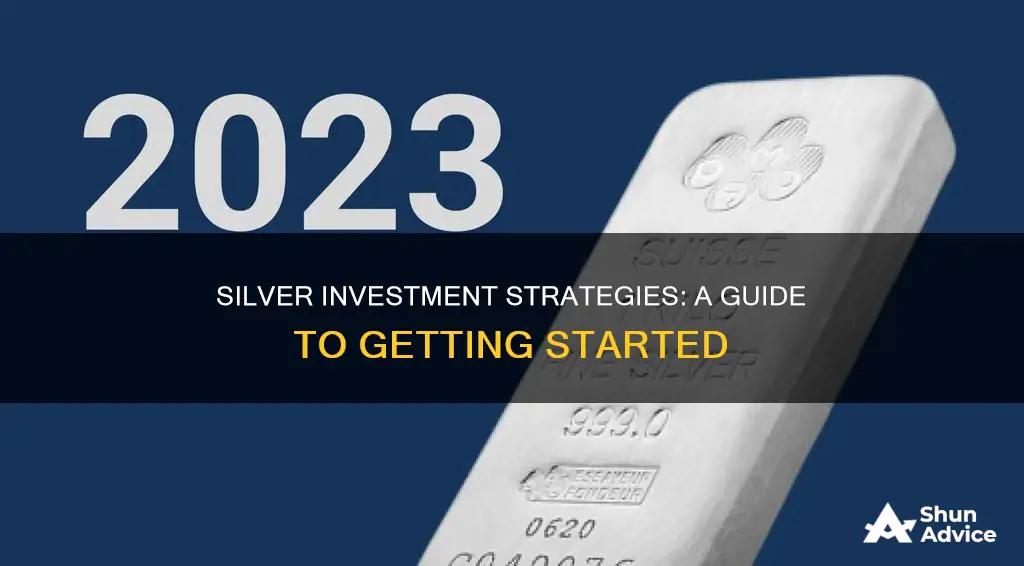
Silver is a popular investment option in the world of precious metals. It is widely regarded as a safe-haven asset, especially during times of economic or political uncertainty, as it can move differently than stocks and bonds. Silver has been used as a store of wealth for 5,000 years and has many industrial, medical, and technological uses. It is also much cheaper than gold, making it more accessible to small retail investors. There are several ways to invest in silver, including purchasing it through a broker, acquiring and storing the physical metal, and buying into funds that invest in silver.
| Characteristics | Values |
|---|---|
| Safe-haven investment | Silver is often thought of as a safe-haven investment in times of economic or political uncertainty. |
| Store of value | Silver can hold its value and even gain value over time, providing a way for investors to generate profits. |
| Liquidity | Silver is a generally liquid market, and certain kinds of silver assets are highly liquid. |
| Less correlated to asset markets | Silver is less correlated to other markets such as stocks, meaning it can act as a hedge against those markets. |
| Diversification | Silver can act as a way to diversify a portfolio, reducing risks and potentially increasing returns. |
| Volatility | Silver, like many commodities, can be quite volatile in the short term. |
| Industrial uses | Silver has many industrial applications in fields such as electronics, solder for pipes, and batteries for electric vehicles. |
| Medical and technological uses | Silver has antimicrobial and non-toxic properties, making it useful for water purification, food storage, and medical applications. |
| Cost of physical silver | Physical silver can be more expensive than its spot price due to manufacturing and distribution markups. |
| Storage of physical silver | Buying physical silver requires finding a safe storage option, which can be challenging and incur additional costs. |
| Silver funds | Silver funds typically charge management fees and may have more complicated tax considerations than stock ownership. |
| Silver stocks | Buying stocks in companies involved in the mining and production of silver is an alternative to purchasing physical silver. |
What You'll Learn

Silver as a safe haven investment
Silver is widely regarded as a safe-haven investment during times of economic or political uncertainty. It is often considered an alternative to traditional investments such as stocks and bonds, as its value tends to move differently from these assets. As a finite asset with limited production potential, silver is also less vulnerable to the impact of sanctions and currency manipulation by governments.
The demand for silver has been increasing due to its wide range of industrial applications, particularly in the healthcare, renewable energy, and electronics sectors. Its excellent electrical conductivity makes it valuable for electric vehicle batteries, solar panels, and the production of chips. This has resulted in a boost in silver prices, with global demand outpacing supply.
However, investing in silver does come with certain risks and drawbacks. Silver does not generate cash flow or interest, so investors rely solely on someone paying more for the metal to make a profit. Its price volatility can also make it a bumpier ride than other investments, and it may be easy to overpay for physical silver.
There are several ways to invest in silver, including purchasing physical silver coins or bullion, buying through a broker, investing in funds or futures contracts, or owning stock in companies involved in silver mining and production. It is important to carefully consider the costs and complexities associated with each option before making any investment decisions.
Shungite's Soaring Value: A Smart Investment or Fleeting Fad?
You may want to see also

Silver's industrial uses
Silver has a wide range of industrial applications, from solar energy to electronics. Its unique properties, such as its high conductivity for electricity and heat, make it a valuable material across various sectors.
Electronics
Silver is widely used in the electronics industry due to its excellent conductivity. It is a key component in everything from mobile phones and computers to gaming consoles and electric appliances. Silver is also used in thermal paste for electronic devices to enhance heat distribution.
Solar Energy
Silver is crucial in the production of photovoltaic cells, which convert sunlight into electricity. Its reflective properties make it highly valuable in the solar energy sector. Silver is also used as a conductive ink in photovoltaic cells, which has led to increased demand from the sector.
Medical Applications
Silver has been used in medicine for thousands of years, with ancient civilizations believing it had healing properties. Today, silver is still used in medical devices and treatments due to its antibacterial properties. It is also used in bandages and medical equipment, as well as in dental applications.
Other Industrial Uses
In addition to the above, silver has various other industrial applications. It is used in solder and brazing alloys, batteries, glass coatings, LED chips, nuclear reactors, photography, RFID chips, semiconductors, touch screens, water purification, wood preservatives, and more. Silver's versatility and strength make it a valuable material across many industries.
The Power of Compounding: Unlocking the Secret to Rapid Investment Growth
You may want to see also

Volatility in the silver market
Silver is widely regarded as a safe-haven investment during times of economic or political uncertainty. It is also considered an alternative to reserve currencies like the dollar and the euro because it is a finite asset with limited production potential. Silver is also less vulnerable to sanctions than assets in dollar- or euro-based financial systems.
However, silver is subject to volatile price swings. For example, silver purchased in 1915 had lost about half of its inflation-adjusted value by 2001. The price of silver spiked to approximately $64 per ounce in 2011 due to concerns about the Federal Reserve's quantitative easing programme and instability in Europe following the global financial crisis.
The volatility in the silver market can be attributed to several factors, including industrial demand, economic and political conditions, and investor sentiment. Silver's industrial applications, such as its use in electronics and soldering, can influence its demand and, consequently, its price. For instance, the increasing demand for electric and hybrid vehicles and renewable energy technologies, such as solar power, can impact the demand for silver and potentially affect its price volatility.
Additionally, economic and political factors play a role in the volatility of the silver market. During times of economic uncertainty or geopolitical instability, investors may flock to safe-haven assets like silver, driving up its price. Similarly, changes in government policies, such as incentives for renewable energy or fluctuations in currencies, can also contribute to price volatility.
Furthermore, investor sentiment and market psychology can significantly influence the volatility of the silver market. When investors anticipate future volatility or perceive shifts in market conditions, it can lead to rapid changes in silver prices, as seen in the 2010-2011 bull market.
It's worth noting that silver's volatility presents opportunities for traders to profit. The dramatic price changes in silver compared to other assets, like gold, offer traders the chance to buy silver at lower prices and sell when it becomes overpriced.
Overall, while silver is a popular investment option, it's essential to recognise the volatility in its market and carefully consider the various factors that can influence its price when making investment decisions.
Retirement Savings Strategies: Navigating Your Golden Years with Confidence
You may want to see also

Silver's role in a diversified portfolio
Silver is a precious metal that has been valued for thousands of years and is considered a stable investment option. It is a finite resource, and its
Investment Strategies: Navigating the World of Smart Spending
You may want to see also

Buying physical silver
Silver is widely regarded as a safe-haven asset. This means that when the returns on traditional investments like stocks and shares decline, investors may consider swapping a proportion of their capital into assets that may hold their value or even increase as other investments' returns fall. Silver is also often considered a safe-haven investment in times of economic or political uncertainty because it can move differently than stocks and bonds.
Silver is much cheaper than gold, making it more accessible to small retail investors who wish to own precious metals as physical assets. Silver can be purchased as physical assets, as either bars and coins held as part of a brokerage account or as American Eagle coins held in a retirement account. The metals would be held by a third-party depository, though investors can take physical delivery if they want to store it themselves.
Bullion bars and coins are the "purest" way to invest in silver, but silver-company stocks and silver-tracking funds and notes can be more convenient to own. Silver is also widely used in industry, including in electronics, solder for pipes in homes, and in high technology, such as smartphones, tablets, automobile electrical systems, and solar-panel cells.
If you want to keep physical silver in your own custody, you'll need to figure out how to store it. It's important to work with a dealer you trust, as buying precious metals can carry the risk of scams. You can purchase silver through local dealers and pawn shops or online dealers such as APMEX or JM Bullion. Dealers will mark up their prices to earn a profit, so it can be easy to overpay for physical silver. Be sure to note the spot price to ensure that you're getting a fair price.
Ideas Are Worthless Without Execution: Why Investors Bet on Action, Not Concepts
You may want to see also
Frequently asked questions
There are several ways to invest in silver, including purchasing it through a broker, acquiring and storing the physical metal yourself, and buying into funds that invest in silver. Another option is owning stock in companies involved in the mining and production of silver.
Silver is often used as a way for buyers to diversify their portfolios. Silver is also a safe-haven investment in times of economic or political uncertainty because it can move differently than stocks and bonds. Silver can also provide some protection against inflation because it tends to rise in price when interest rates fall behind the rising cost of living.
Silver does not produce cash flow, so it may not be clear when it’s a good time to buy. Silver is also subject to price volatility, which can be challenging when managing portfolio risk.







